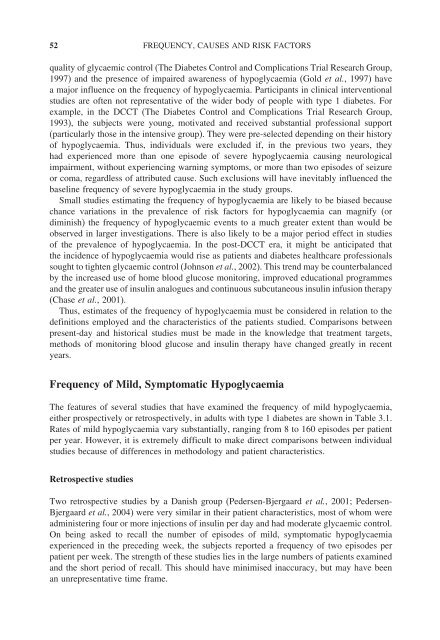Hypoglycaemia in Clinical Diabetes
Hypoglycaemia in Clinical Diabetes
Hypoglycaemia in Clinical Diabetes
- No tags were found...
You also want an ePaper? Increase the reach of your titles
YUMPU automatically turns print PDFs into web optimized ePapers that Google loves.
52 FREQUENCY, CAUSES AND RISK FACTORSquality of glycaemic control (The <strong>Diabetes</strong> Control and Complications Trial Research Group,1997) and the presence of impaired awareness of hypoglycaemia (Gold et al., 1997) havea major <strong>in</strong>fluence on the frequency of hypoglycaemia. Participants <strong>in</strong> cl<strong>in</strong>ical <strong>in</strong>terventionalstudies are often not representative of the wider body of people with type 1 diabetes. Forexample, <strong>in</strong> the DCCT (The <strong>Diabetes</strong> Control and Complications Trial Research Group,1993), the subjects were young, motivated and received substantial professional support(particularly those <strong>in</strong> the <strong>in</strong>tensive group). They were pre-selected depend<strong>in</strong>g on their historyof hypoglycaemia. Thus, <strong>in</strong>dividuals were excluded if, <strong>in</strong> the previous two years, theyhad experienced more than one episode of severe hypoglycaemia caus<strong>in</strong>g neurologicalimpairment, without experienc<strong>in</strong>g warn<strong>in</strong>g symptoms, or more than two episodes of seizureor coma, regardless of attributed cause. Such exclusions will have <strong>in</strong>evitably <strong>in</strong>fluenced thebasel<strong>in</strong>e frequency of severe hypoglycaemia <strong>in</strong> the study groups.Small studies estimat<strong>in</strong>g the frequency of hypoglycaemia are likely to be biased becausechance variations <strong>in</strong> the prevalence of risk factors for hypoglycaemia can magnify (ordim<strong>in</strong>ish) the frequency of hypoglycaemic events to a much greater extent than would beobserved <strong>in</strong> larger <strong>in</strong>vestigations. There is also likely to be a major period effect <strong>in</strong> studiesof the prevalence of hypoglycaemia. In the post-DCCT era, it might be anticipated thatthe <strong>in</strong>cidence of hypoglycaemia would rise as patients and diabetes healthcare professionalssought to tighten glycaemic control (Johnson et al., 2002). This trend may be counterbalancedby the <strong>in</strong>creased use of home blood glucose monitor<strong>in</strong>g, improved educational programmesand the greater use of <strong>in</strong>sul<strong>in</strong> analogues and cont<strong>in</strong>uous subcutaneous <strong>in</strong>sul<strong>in</strong> <strong>in</strong>fusion therapy(Chase et al., 2001).Thus, estimates of the frequency of hypoglycaemia must be considered <strong>in</strong> relation to thedef<strong>in</strong>itions employed and the characteristics of the patients studied. Comparisons betweenpresent-day and historical studies must be made <strong>in</strong> the knowledge that treatment targets,methods of monitor<strong>in</strong>g blood glucose and <strong>in</strong>sul<strong>in</strong> therapy have changed greatly <strong>in</strong> recentyears.Frequency of Mild, Symptomatic <strong>Hypoglycaemia</strong>The features of several studies that have exam<strong>in</strong>ed the frequency of mild hypoglycaemia,either prospectively or retrospectively, <strong>in</strong> adults with type 1 diabetes are shown <strong>in</strong> Table 3.1.Rates of mild hypoglycaemia vary substantially, rang<strong>in</strong>g from 8 to 160 episodes per patientper year. However, it is extremely difficult to make direct comparisons between <strong>in</strong>dividualstudies because of differences <strong>in</strong> methodology and patient characteristics.Retrospective studiesTwo retrospective studies by a Danish group (Pedersen-Bjergaard et al., 2001; Pedersen-Bjergaard et al., 2004) were very similar <strong>in</strong> their patient characteristics, most of whom wereadm<strong>in</strong>ister<strong>in</strong>g four or more <strong>in</strong>jections of <strong>in</strong>sul<strong>in</strong> per day and had moderate glycaemic control.On be<strong>in</strong>g asked to recall the number of episodes of mild, symptomatic hypoglycaemiaexperienced <strong>in</strong> the preced<strong>in</strong>g week, the subjects reported a frequency of two episodes perpatient per week. The strength of these studies lies <strong>in</strong> the large numbers of patients exam<strong>in</strong>edand the short period of recall. This should have m<strong>in</strong>imised <strong>in</strong>accuracy, but may have beenan unrepresentative time frame.
















